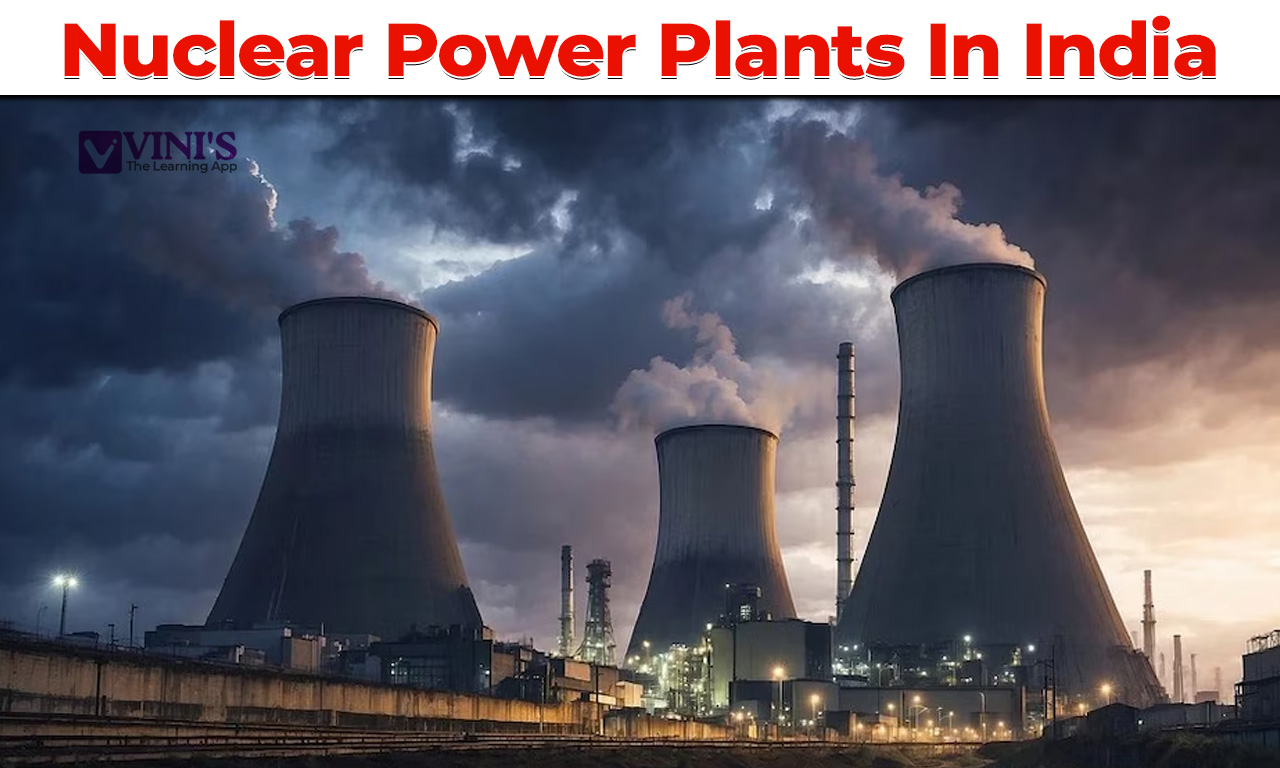Nuclear Power Plants In India: Are you aware of the oldest nuclear power plant in India? The Tarapur Atomic Power Plant-1 (TAPS-1) holds the distinction of being the first and oldest Nuclear Power Plants in the country. For candidates preparing for competitive exams or government tests, such as SSC, RRB, banking, and insurance exams, a thorough understanding of nuclear power plants in India is essential. This topic is often featured in the general awareness section, which plays a crucial role in the syllabus for these exams. UPSC aspirants should also review the list of nuclear power stations in India carefully, as questions related to this topic may appear in the UPSC Prelims.
Nuclear Power Plants In India
The operation phase is typically the longest stage in the life cycle of a nuclear power plant. Currently, India operates 22 reactors, with a total installed capacity of 6,780 MWe. Of these, 18 are Pressurised Heavy Water Reactors (PHWRs) and 4 are Light Water Reactors (LWRs). Check out the list of Nuclear Power Plants In India below:-
| Nuclear Power Plants in India – Operational | |||
| Name Of Nuclear Power Station | Location | Operator | Capacity |
| Kakrapar Atomic Power Station – 1993 | Gujarat | NPCIL | 440 |
| (Kalpakkam) Madras Atomic Power Station – 1984 | Tamil Nadu | NPCIL | 440 |
| Narora Atomic Power Station- 1991 | Uttar Pradesh | NPCIL | 440 |
| Kaiga Nuclear Power Plant -2000 | Karnataka | NPCIL | 880 |
| Rajasthan Atomic Power Station – 1973 | Rajasthan | NPCIL | 1,180 |
| Tarapur Atomic Power Station – 1969 | Maharashtra | NPCIL | 1,400 |
| Kudankulam Nuclear Power Plant – 2013 | Tamil Nadu | NPCIL | 2,000 |
List of Nuclear Power Stations in India (Under Construction)
Below is the list of Nuclear Power Stations in India that are under construction:-
| Nuclear Power Plants in India – Under Construction | |||
| Name Of Nuclear Power Station | Location | Operator | Capacity |
| Madras (Kalpakkam) | Tamil Nadu | BHAVINI | 500 |
| Rajasthan Unit 7 and 8 | Rajasthan | NPCIL | 1,400 |
| Kakrapar Unit 3 and 4 | Gujarat | NPCIL | 1,400 |
| Kudankulam Unit 3 and 4 | Tamil Nadu | NPCIL | 2,000 |
Nuclear Power Plants in India (Future Projects)
Here is the list of the Nuclear Power Stations in India that are being planned to be constructed in the future:-
| Nuclear Power Plants in India – Planned (Future projects) | |||
| Name Of Nuclear Power Station | Location | Capacity | |
| Tarapur | Maharashtra | 300 | |
| Madras | Tamil Nadu | 1,200 | |
| Kaiga | Karnataka | 1,400 | |
| Chutka | Madhya Pradesh | 1,400 | |
| Gorakhpur | Haryana | 2,800 | |
| Bhimpur | Madhya Pradesh | 2,800 | |
| Mahi Banswara | Rajasthan | 2,800 | |
| Haripur | West Bengal | 4,000 | |
| Mithi Virdi (Viradi) | Gujarat | 6,000 | |
| Kovvada | Andhra Pradesh | 6,600 | |
| Jaitapur | Maharashtra | 9,900 | |
Nuclear Power Plants in India: Interesting Facts
- Early Adoption: India was one of the early adopters of nuclear energy for peaceful purposes. The country’s nuclear power programme began in the 1940s with the establishment of the Atomic Energy Commission in 1948.
- Indigenous Technology: India has developed indigenous nuclear reactor technology. The Pressurised Heavy Water Reactors (PHWRs), which are used in many of India’s nuclear plants, are a testament to the country’s self-reliance in nuclear technology.
- Innovative Fuel: India has pioneered the use of thorium-based fuel. The country is developing a thorium-based reactor programme to make use of its large thorium reserves and enhance its energy security.
- Longest Operating Reactor: The Tarapur Atomic Power Station (TAPS) is not only the oldest nuclear power plant in India but also has been operational for over five decades, showcasing the longevity and reliability of Indian nuclear technology.
- World-Class Safety Standards: Indian nuclear power plants adhere to rigorous safety standards. The safety measures include advanced containment systems, redundancy in critical safety systems, and comprehensive emergency preparedness plans.
- Kudankulam’s Largest: The Kudankulam Nuclear Power Plant (KKNPP) is the largest in India by installed capacity, with its two reactors each having a capacity of 1,000 MWe. This plant represents a significant step in India’s nuclear power expansion.
- Significant Research Hub: The Bhabha Atomic Research Centre (BARC) in Mumbai is a major research hub that supports India’s nuclear power programme. It conducts research in nuclear physics, reactor technology, and nuclear safety.
- International Collaboration: India has partnered with various countries to enhance its nuclear capabilities. The collaboration with Russia for the Kudankulam plant is a notable example, showcasing international cooperation in advancing nuclear technology.
- Nuclear Fuel Cycle: India’s nuclear power plants use a closed fuel cycle, which involves reprocessing spent fuel to extract usable materials, thereby reducing nuclear waste and making the use of nuclear energy more sustainable.
- Future Plans: India has ambitious plans to significantly increase its nuclear power capacity. The country aims to expand its nuclear fleet and achieve a substantial portion of its electricity needs through nuclear energy by 2030.
Also, check out the list of longest rivers in the world.











